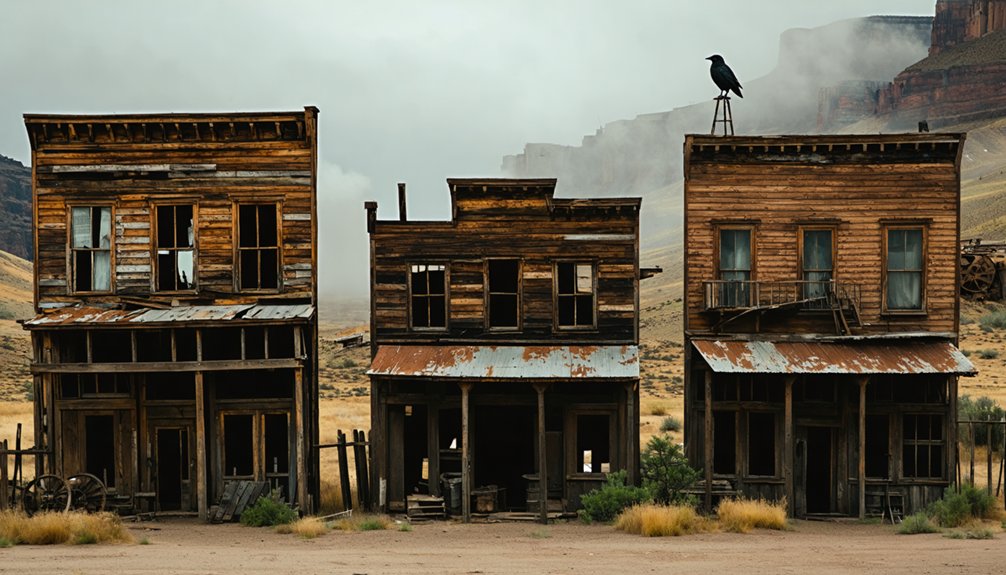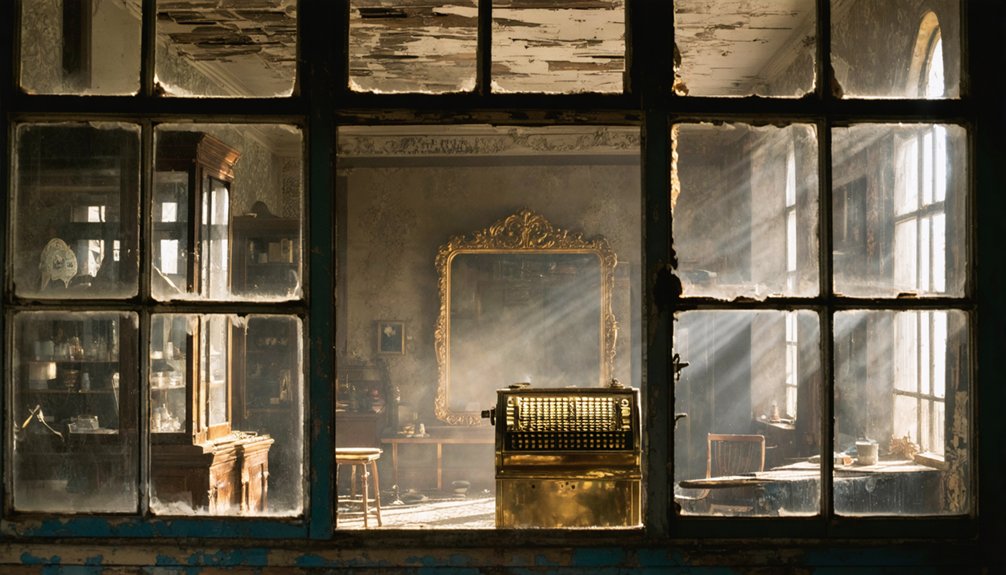You’ll find America’s most haunting Victorian ghost towns in Bodie, California, Virginia City, Nevada, and Bannack, Montana. Each preserves the boom-and-bust cycle of 1800s mining communities where gold and silver discoveries created prosperous but lawless towns that later faced abandonment. Today, their weathered wooden structures, rusty mining equipment, and spectral legends draw history buffs and paranormal enthusiasts. These frozen-in-time settlements offer more than just empty buildings.
Key Takeaways
- Bodie, California preserves 170 buildings in “arrested decay,” with reports of curses befalling visitors who remove artifacts.
- Virginia City, Nevada features the haunted Washoe Club where paranormal investigators document frequent ghostly encounters.
- Bannack, Montana is known for apparitions of outlaw sheriff Henry Plummer and his gang who terrorized miners.
- All three towns flourished during the Victorian era (1837-1901) and maintain authentic structures from this time period.
- These ghost towns offer paranormal tours where visitors regularly report cold spots, disembodied voices, and shadowy figures.
Bodie, California: The Gold Rush Town Frozen in Time
Nestled in the eastern Sierra Nevada Mountains near Mono Lake, Bodie stands as one of America’s most authentic Victorian-era ghost towns, frozen in time since the gold rush days.
Following William S. Bodey’s gold discovery in 1859, the town exploded after a rich ore vein was uncovered in 1875, swelling to 10,000 residents by 1879.
From dust to boomtown: a gold vein transformed Bodie into a thriving metropolis of 10,000 souls within just four years.
You’ll find Bodie preservation efforts maintain roughly 170 buildings in “arrested decay” – an authentic snapshot of the Wild West.
The town earned its “Badman from Bodie” reputation through violence and lawlessness, with Bodie legends of gambling and deadly bar fights contributing to its notorious status. This infamous reputation made Bodie as notorious as other wild western towns like Tombstone and Deadwood.
The town’s historical significance was acknowledged when it was officially designated the state gold rush ghost town of California in 2002.
By 1942, the mines had closed, and residents abandoned homes with possessions intact.
Now California’s official gold rush ghost town, Bodie offers you a genuine glimpse into America’s untamed frontier past.
Virginia City, Nevada: Silver Lode Legacy and Spectral Saloons
While Bodie exemplifies a gold-rush ghost town preserved in arrested decay, Virginia City emerges as the silver counterpart with an equally compelling yet distinct story.
Perched at 6,200 feet on Mount Davidson’s eastern slope, this former boomtown exploded after Irish immigrants discovered the Comstock Lode in 1859—America’s first major silver deposit.
Virginia City’s mining history includes four remarkable elements:
- The unprecedented wealth that transformed a settlement into a 25,000-person metropolis
- Revolutionary square-set timbering techniques that enabled safe underground extraction
- Cultural diversity that created a vibrant social fabric despite harsh conditions
- Production of approximately $180 million over 22 years from mines like Consolidated Virginia
The town suffered a devastating setback when a significant fire in the 1870s caused $10 million in damage, destroying much of the original settlement.
Today, you’ll find Victorian buildings housing ghostly legends of miners, madams, and magnates—making it one of America’s most paranormally active locations. Visitors can explore this haunted legacy at the Washoe Club and other sites featured on numerous paranormal television shows.
Bannack, Montana: From “Toughest Town in the West” to Haunted Historic Landmark
Steeped in the tumultuous legacy of America’s frontier gold rush, Bannack, Montana stands as a chilling memorial to the volatile boom-and-bust cycle that defined Victorian-era mining communities. Founded in 1862 following a major gold discovery, this former territorial capital quickly gained notoriety for its lawlessness under Sheriff Henry Plummer, who secretly led a gang of outlaws before vigilantes executed him in 1864.
Today, Bannack history lives on through more than 60 preserved structures that maintain their original condition rather than undergoing restoration. The once-prosperous town saw its population dwindle to only one resident by 1953 when C.W. Stallings owned the entire settlement. The town’s population once reached 10,000 miners during the height of the gold rush era.
You’ll experience an authentic ghost town where echoes of its violent past manifest in numerous ghostly encounters. Visitors regularly report unexplained noises, apparitions of women in period clothing, and sensations of being watched—making Bannack one of America’s most genuinely haunted abandoned settlements.
Frequently Asked Questions
How Did Victorian-Era Entertainment Differ in These Mining Towns?
All that glitters is not gold. You’d find theatrical performances in mining towns were rougher yet culturally ambitious, while community gatherings in saloons and baseball games balanced isolated frontier life with social connection.
What Diseases Were Common in These Towns’ Population?
You’d face tuberculosis outbreaks, cholera epidemics, typhoid fever, smallpox, and scarlet fever in these towns, where poor sanitation and cramped living conditions accelerated disease transmission and mortality rates.
How Did Women’s Roles Evolve in These Frontier Communities?
You’d find women’s roles expanded beyond Victorian domesticity due to frontier necessity. They contributed critical women’s labor in mining towns and created alternative social structures through brothels, businesses, and caregiving institutions.
What Caused These Towns to Decline After Their Peak Periods?
You’ll find these towns declined through economic downturns when resources depleted, transportation routes changed, environmental factors rendered areas uninhabitable, and technological advances eliminated their foundational industries and commercial relevance.
Were Indigenous Populations Involved in These Ghost Towns’ Histories?
Yes. You’ll find indigenous peoples were central to these towns’ histories through indigenous displacement that facilitated settlement and complex cultural interactions in labor, trade, and conflict throughout their development and decline.
References
- https://www.christywanders.com/2024/08/top-ghost-towns-for-history-buffs.html
- https://www.tastingtable.com/694562/scariest-ghost-towns-country/
- https://www.visittheusa.com/experience/5-us-ghost-towns-you-must-see
- https://www.youtube.com/watch?v=iNEJyuneSDM
- https://devblog.batchgeo.com/ghost-towns/
- https://en.wikipedia.org/wiki/List_of_reportedly_haunted_locations_in_the_United_States
- https://www.geotab.com/ghost-towns/
- https://www.atlasobscura.com/lists/americas-best-preserved-ghost-towns
- https://www.slideshare.net/slideshow/famous-ghost-towns/26047073
- https://en.wikipedia.org/wiki/Lists_of_ghost_towns_in_the_United_States



